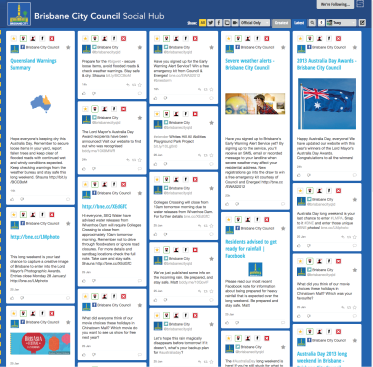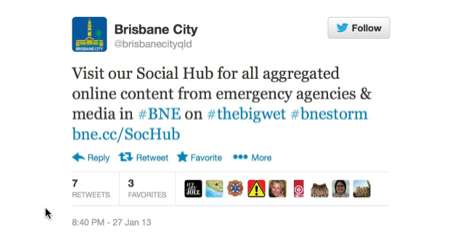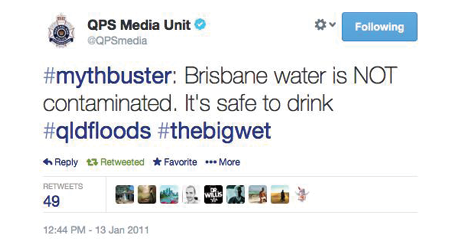
This paper is based on a presentation given at the ANZDMC Conference (Brisbane) in March 2014.
Government organisations tasked with emergency response must ensure that critical, validated messages cut through social media ‘white noise’. With increased use of social media, emergency messages often originate from members of the public before traditional emergency response organisations are activated. Faced with a multitude of channels and social media updates in emergency response operations, identifying authoritative sources and their most current messaging can prove difficult for the public in a heightened state of emergency response.
Social media refers to ‘interaction among people in which they create, share and/or exchange information and ideas in virtual communities and networks’ (Ahlqvist et al. 2008, p. 39). Common examples of social media include platforms such as Facebook, Twitter, YouTube, and Instagram, with Facebook and Twitter being the dominant channels chosen for use in emergency response (Using Social Media for Emergency Notification 2010). Recent emergency response events have demonstrated an increase in social media use as a crisis communication tool by individuals and emergency response organisations. For example, the earthquake events in Haiti (2010) and New Zealand (2011) saw the emergence of social media at the forefront of crisis response, with crowd mapping in the former (Yates & Paquette 2011), and Facebook employed widely in the latter (Dabner 2011). Similarly, Instagram images provided emergency responders with useful insight during Hurricane Sandy (Coscarelli 2012).
For crisis communicators, ensuring the right audiences receive the right message and respond accordingly is a significant part of effective social media use in a crisis. Crisis communication is defined for the purpose of this paper as:
‘a perception of an unpredictable event that threatens important expectancies of stakeholders and can seriously impact an organisation’s performance and generate negative outcomes’ (Coombs 2007, p. 2).
During a natural disaster, social media messages may centre on the people affected, or issues such as shelter, transport, food and other key necessities (Bird, Ling & Haynes 2012, Shaw et al. 2013, Taylor et al. 2012, Velev & Zlateva 2012). Wendling, Radisch and Jacobzone (2013) posit that there are increased expectations for government to use social media as part of their emergency response procedures. Use of social media at the height of a crisis can, however, be problematic. For example, Hart (2011) suggests the rapid and consistent release of information during an emergency can be fraught with delays and difficulties, including issues of access to technology, service disruptions, or general confusion about information sources.
Previous emergency responses show that mobile networks are relatively resilient and often remain operational during emergency events (Dufty 2011). A key challenge is that sharing content can lead to a rapid penetration of information in a short period of time that can eventuate in a ‘long tail’ (Anderson 2006). The term ‘long tail’ refers to a phenomenon in which posted information that has become redundant ‘lives on’ via social media sharing; this impacts on the viability of new, relevant information. If social media channels are not effectively used and monitored, ‘social media information and activity simply becomes undistinguishable white noise that neither alerts nor corrects, which can be disastrous when a quick and effective response is critical’ (Crowe 2014, p. 123). One solution to eradicate this ‘noise’ and ensure that key information is received is to aggregate content in one central area that consistently updates.
Use of social media has become a key method of communication allowing emergency services agencies to broadcast and amplify critical information and emergency warnings to the public and other lead agencies (Banks 2011). In the evolution from traditional, centralised emergency response to a decentralised, citizen-led response process, it is crucial that organisations work to combat the risk of ‘white noise’ in social media during an emergency situation and, instead, find ways of collating and promoting information that is current, relevant and timely. This became evident for Brisbane City Council during the January 2013 weather event.
This paper examines the social media communication approach taken by Brisbane City Council during the January 2013 extreme weather event. It focuses on the use of Council’s Social Hub social media aggregation tool during the period 24-31 January 2013. The objective is to show the problem, solution, justification and execution of deploying a Social Hub as a means of cutting out white noise in social media during an emergency or disaster situation. Key metrics and information from the Social Hub have been examined as part of the larger methodology including growth, number of visitors, content, reach and public feedback. To obtain these metrics, the inbuilt analysis tools of the Social Hub were used alongside a more detailed analysis from social media monitoring program.
During the Australia Day weekend in 2013, Brisbane faced a significant flood emergency. Floodwaters were expected to inundate the city and Brisbane City Council activated their Local Disaster Coordination Centre (LDCC).
To address the risk of important emergency messages being buried in social media channels, the Council deployed a social media aggregation tool known as a ‘Social Hub’. The Social Hub is a ‘one-stop-shop’ interactive web-based page where individuals can find relevant emergency information and information from other lead agencies, emergency responders, media and the community. It was deployed to deal with three imperatives, which were set by Council and derived from recent flood experiences in 2011. The imperatives were:
Brisbane City Council has an active and engaged online community and it was important that information was provided through the various stages of the crisis event. This included the preparedness stage to the recovery stage. Many businesses were closed for the Australia Day holiday so traditional methods of sharing information proved more difficult.
A Social Hub is a social media aggregator tool that can be customised and deployed via a public URL (social.brisbane.qld.gov.au). By putting key information in one location it is easier to minimise ‘white noise’. Emergency managers use the tool to validate information, while the community views it to make decisions on their safety. Without ‘tools to aggregate and validate the plethora of rumours, anecdotes and buzz-worthy information, it was challenging for impacted individuals to get a clear, concise, and accurate picture of what had happened’ (Crowe 2014, p. 122).
Brisbane City Council deployed the Social Hub in mid-2012. It was not promoted as a critical source of emergency information, but rather as a general location for Council information. The Social Hub works by aggregating content from Facebook, Twitter, YouTube, Flickr, Pinterest, Instagram and RSS feeds based on keywords or specific accounts. Content from the Council’s website and content from other lead agencies was aggregated. Figure 1 shows the Social Hub during an emergency response.
Figure 1: Brisbane City Council Social Hub, Australia Day 2013.

The Social Hub allowed the Council to arrange information based on ‘latest’ or ‘greatest’. During an emergency information is displayed as ‘latest’ to show newest information first, rather than highest engaged content. The information dynamically updates ensuring critical information appears at the top of the page. Crowe (2014) highlights the importance of aggregation by stating that:
‘… aggregation is critical to the validation of time-sensitive social media information. This type of information is most common in disasters and emergencies due to the ever-changing flow of information during an event and immediately afterward as the picture comes into focus. It is critical to understand whether information is event related or simply indistinguishable white noise.’ (p.125)
The system features a manual override where important information can be pinned to the top of the page to ensure as many individuals as possible see it when they first visit. A ‘collective voice’ also means content valued highly by the community can be featured on the Social Hub. The ability to ‘vote up’ content is similar to sites such as StumbleUpon and Reddit. This facility allows the community, as well as content providers, to use a collective voice and promote content on the Social Hub.
The Theory of Social Validation (Weinschenk 2009) states, ‘when people are uncertain about what to do we will look to other people to guide us... and we do this automatically and unconsciously.’ (as cited in Akil 2009). Within the Social Hub, the application of social validation is evident. Content the Council and the community views as important is pinned to the top to be shared with others or voted as critical. Within Brisbane City Council Digital Services Team, there is an accepted benchmark for validating content that is often summed up as ‘if ten people tell you the road is closed, the road is closed’. The guiding principle behind this ideology is that in the social media space community members validate each other’s content and original posters have vested interests in being seen as authoritative sources. Via the Social Hub, the social validation of information translates to an ability to prioritise information and an improved situational awareness. Validation is an important step in both the public consumption and internal use of information.
Consistent with Social Validation Theory, site content was collated from pre-approved social media accounts from Brisbane City Council, Queensland Police, SES, Energex, 4BC Brisbane, 612ABC Brisbane, ABC Radio Brisbane and TransLink. These agencies are part of Council’s ‘Credible Sources List’ and their information is deemed trusted, authoritative and is prioritised. During the Australia Day storm, the Council’s Social Hub received over 230 001 page views with 72 per cent of visitors returning. Council’s tweets about the Social Hub reached over 93 266 people on Twitter. Figure 2 shows one of the tweets shared.
Figure 2: Tweet from Brisbane City Council on the Social Hub.

Issues identified from the 2011 flood event influenced the strategic implementation of the Social Hub by Brisbane City Council. For example, despite factual information being released via social and traditional media, questions around the safety of drinking water continued for 48 hours after erroneous reports. In an attempt to stem this misinformation and the ‘long tail’ effect (Anderson 2006) the Queensland Police Service used the #mythbuster hashtag as shown in Figure 3.
Figure 3: QPS Media tweet regarding false information about drinking water.

The collective voice or wisdom of the crowd, when influenced by key agencies, also enables self-correction (Surowiecki 2004). The community is motivated to amend erroneous information, particularly when external authorities intervene. Social media eventually has a leveling effect where erroneous information is corrected due to users being invested in ensuring their information is validated (Crowe 2104). Emergency response agencies using social media aggregation tools can also easily see misinformation and can intervene.
As a visual representation of social media in real-time, the Social Hub was strategically deployed to increase visibility of key messages to users who may not be comfortable using dedicated social media channels such as Facebook and Twitter. By having a ‘one-stop-shop’ available via a website, people without Facebook or Twitter accounts are able to get the same information as others, as exemplified in the story of a Sydney resident who used the Social Hub to update her elderly mother in Brisbane. With important content being pinned to the top of the Social Hub, the resident was able to call her mother and inform her about evacuation information, transport disruptions and weather updates.
The Social Hub is an evolution from existing aggregation tools that have proven successful in crisis, such as Twitter lists (Holdeman 2009). In the January 2011 floods, the Council created a Twitter list of all relevant lead agencies, media and influential community members. It was used as an active means of consolidating information and reducing noise, clearly demonstrating the utility of aggregating social media content to improve validity and extend the reach of messages.
Brisbane City Council’s experience suggests that aggregation tools in social media can combat white noise during an emergency situation and provide validated, easily located content to both the public and emergency management staff. To achieve cut-through and validation in the space, crisis communications delivered by organisations must be:
To deliver viable communication via social media during an emergency, organisations can ensure they achieve cut-through by implementing a social media aggregation tool. Without this, white noise in social media can become distracting, be detrimental to preparedness, action and recovery, and can be misleading. The adoption and evolution of social media use requires organisations to find ways of sharing information in a visually appealing, easy-to-access way that lends itself to social validation and easy syndication. The Social Hub is an integrated part of Disaster Operations at Brisbane City Council and is used across areas such as the city’s Contact Centre. The Social Hub has been a successful deployment of a social media aggregation tool during an emergency response and offers a model for other organisations to consider.
Ahlqvist T, Bäck A, Halonen M & Heinonen S 2008, Social media road maps exploring the futures triggered by social media. VTT Tiedotteita – Valtion Teknillinen Tutkimuskeskus (2454): p. 13.
Akil B 2009, The Theory of Social Validation. Psychology Today. At: www.psychologytoday.com/blog/communication-central/200909/the-theory-social-validation, [3 February 2014].
Anderson C 2006, The Long Tail: Why the Future of Business Is Selling Less of More. New York: Hyperion.
Banks L 2011, Q&A: Emergency 2.0 Wiki. At: www.computerworld.com.au/article/400312/q_emergency_2_0_wiki, [17 February 2014].
Bird D, Ling M & Haynes K 2012, Flooding Facebook – the use of social media during the Queensland and Victorian floods. The Australian Journal of Emergency Management, vol. 27, no. 1, pp. 27-33.
Coombs J 2007, Ongoing Crisis Communication. Planning, Managing and Responding (second edition). Thousand Oaks: Sage Publications Inc.
Coscarelli J 2012, Hurricane Sandy: A Perfect Social Media Storm. Retrieved March 10, 2014. At: http://nymag.com/daily/intelligencer/2012/10/hurricane-sandy-perfect-social-media-storm.html.
Crowe A 2014, Disaster 2.0: The Application of Social Media Systems for Modern Emergency Management [Kindle Edition]. CRC Press. Retrieved from Amazon.com.
Dabner N 2011, ‘Breaking Ground’ in the use of social media: A case study of a University earthquake response to inform educational design with Facebook. The Internet and Higher Education, 15, 1, pp. 69-78.
Dufty N 2011, Using Social Media for Natural Disaster Resilience. DCAP.
Hart L 2011, Social media in Doorley, J. and Garcia, H.F. (Eds) Reputation Management: The Key to Successful Public Relations and Corporate Communication, CRC Press, Boca Raton, FL, pp. 113-33.
Holdeman E 2009, Fort Hood Shooting and Social Media Accuracy. Emergency Management Magazine, Nov 7.
Shaw F, Burgess J, Crawford K & Bruns A 2013, Sharing news, making sense, saying thanks: Patterns of talk on Twitter during the Queensland floods. Australian Journal of Communication, 40(1), pp. 23-40.
Surowiecki J 2004, The Wisdom of Crowds. Doubleday: Anchor.
Taylor M, Wells G, Howell G & Raphael B 2012, The role of social media as psychological first aid as a support to community resilience building: a Facebook study from ‘Cyclone Yasi’ Update. Australian Journal of Emergency Management, vol. 27, no. 1, pp. 20-26.
Using Social Media for Emergency Notifications 2010, At: http://idisaster.files.wordpress.com/2010/06/socialmediaforemergencymanagers.pdf, [8 February 2014].
Velev D & Zlateva P 2012, Use of social media in natural disaster management. International Procedure of Economic Development and Research. 39, pp. 41-45.
Weinschenk S 2009, Neuro web design: What makes them click? Berkeley: New Riders.
Wendling C, Radisch J & Jacobzone S 2013, The Use of Social Media in Risk and Crisis Communication. OECD Working Papers on Public Governance, No. 25, OECD Publishing. http://dx.doi.org/10.1787/5k3v01fskp9s-en.
Yates D & Paquette S 2011, Emergency knowledge management and social media technologies: A case study of the 2010 Haitian earthquake. International Journal of Information Management, 31, pp. 6-13.
Tracy Whitelaw is researching social media use in crisis communication as a PhD student at Bond University. She works as a Senior Social Media Strategist for Brisbane City Council.
Co-author, Dr Donna F Henson is an Assistant Professor of Communication in the Faculty of Society and Design at Bond University. Her research interests currently center on meaning-making post-trauma, narrative, autoethnography and communication.